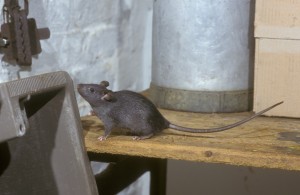Although we’re enjoying (or cursing) unseasonably warm weather in Sacramento this fall, eventually cooler weather and rain (if we’re lucky) will set in for the winter. The cooler weather drives rats and mice indoors, looking for a warm, dry place to nest and raise their young. That’s why at this time of year calls from customers who suspect they have a rodent problem skyrocket.

Scientists characterize urban rodents—in particular the house mouse, Norway rat and roof rat, or black rat—as among the world’s most “successful” mammals, right up there with humans. As noted rodentologist Bobby Corrigan wrote recently for PCT Magazine, rodents are successful for six reasons: 1) they adapt easily to different types of structures and environments; 2) they reproduce quickly when conditions are good; 3) they can raise whole families in very small spaces; 4) they are secretive, elusive, active at night and alert to danger; 5) their body shapes and colors help them to hide; and 6) they are relatively smart. “Rats, for example, are considered to be highly intelligent,” Corrigan writes for PCT, “because research has proven they can learn and perform new tasks — an important asset when entering a new building or area for the first time.”
Corrigan cites several qualities of roof rats that have allowed them to adapt so successfully to civilization:
- They navigate easily in high spaces above the sightline of humans and other natural predators, such as dogs and skunks.
- They nest in difficult-to-access spaces—attics, ceiling spaces, dense foliage and treetops.
- They range 500 feet or more to find food, often crossing multiple property lines. Where do you begin to treat?
- They move in and out of homes and buildings, living indoors for a few weeks or months, then moving outdoors into trees or bushes.
But we know from experience, that colder, rainy weather tends to move them inside—often into your attic or crawlspace.
A rodent problem is not one that can be left untreated. Not only do rats and mice cause significant property damage—chewing through wires and cables, gnawing woodwork and other structures, creating fire hazards—they carry a number of diseases harmful to humans. If left to nest comfortably in your attic, basement storeroom, or backyard shed, a few rats will quickly become an army. According to the University of California-Davis Statewide Integrated Pest Management Program, “The average number of litters a female roof rat has per year depends on many factors, but generally it is 3 to 5 with 5 to 8 young in each litter.”
In order to effectively protect your home from rats or mice, the first step is to determine where the pests are most active and how they are getting in, and treat those areas first. (For a list of signs you have a rat or mouse infestation, check out this UC Davis Integrated Pest Management publication: http://www.ipm.ucdavis.edu/PMG/PESTNOTES/pn74106.html.) The second step is to clean and sanitize the area, removing rodent droppings and urine stains, repair any damage to wiring, wall board or woodwork, and replacing dirty and damaged insulation, preferably with an environmentally friendly insulation product containing a pest repellent. The final step is to rodent-proof your space so that you won’t have a repeat of the problem the next time the weather takes a turn.
Your licensed pest professional is trained to inspect your home or business; determine where the rats are coming in; where the rats are active now versus old, inactive sites; and how much damage has been done. Our company’s service also includes cleanup and sterilization, repairs, reinsulation with a “green” product that rats don’t like, and rat-proofing the area to prevent the critters from coming back in.


